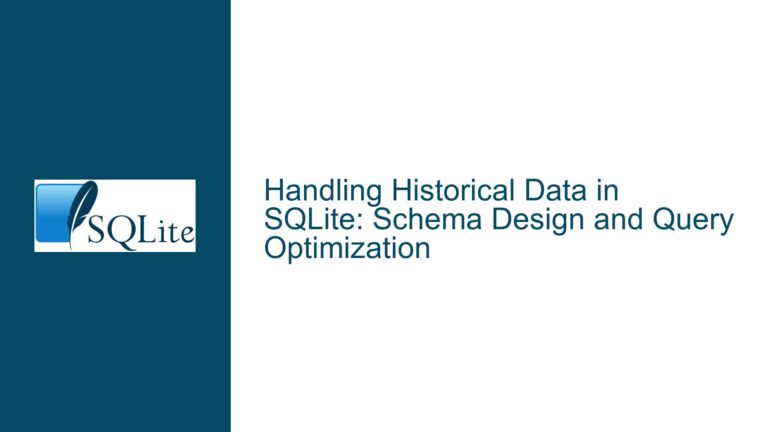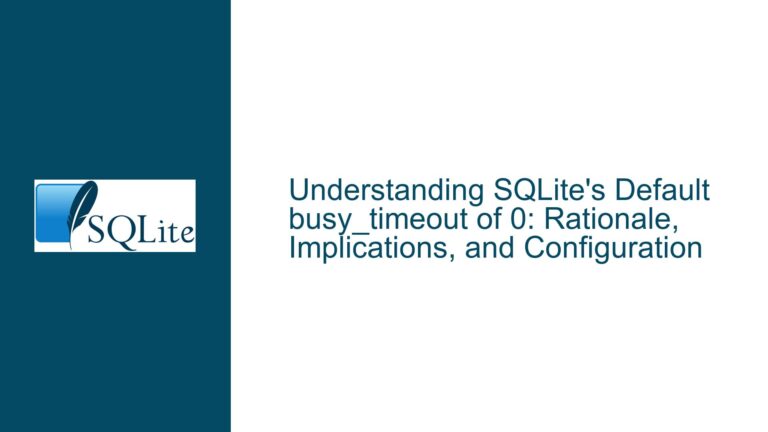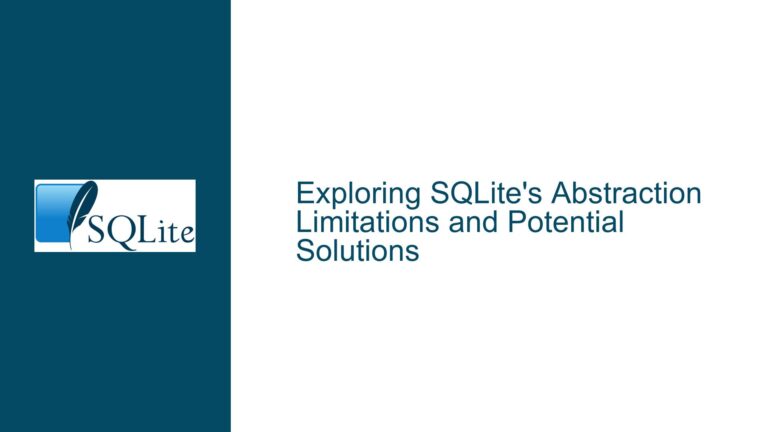CHECK Constraints in STRICT Tables Not Enforced During DDL Validation
STRICT Table Type Enforcement vs. CHECK Constraint Evaluation Logic
Understanding the Conflict Between Column Type Enforcement and Expression-Based Constraints
The core issue revolves around the interaction between SQLite’s STRICT table type enforcement and the evaluation of CHECK constraints defined on columns. When a table is declared with the STRICT keyword, SQLite enforces strict type affinity for columns, meaning values inserted or updated must directly match the declared column type (e.g., INTEGER, TEXT) without implicit type coercion. However, CHECK constraints are evaluated independently of this type enforcement mechanism, leading to scenarios where constraints may reference values that are fundamentally incompatible with the column’s strict type.
For example, consider a STRICT table defined as:
CREATE TABLE strict_value (
value INTEGER CHECK (value IN (1, 'two'))
) STRICT;
Here, the CHECK constraint explicitly allows the value 'two', which is a string literal. However, because the column value is declared as INTEGER in a STRICT table, inserting 'two' would fail during runtime due to type enforcement—even though the CHECK constraint appears to permit it. The conflict arises because the CHECK constraint is not validated against the column’s strict type affinity during Data Definition Language (DDL) operations like CREATE TABLE. Instead, it is only enforced during Data Manipulation Language (DML) operations like INSERT or UPDATE.
This behavior creates a disconnect between schema design expectations and runtime outcomes. Developers may assume that the presence of STRICT and a CHECK constraint would result in comprehensive validation at schema creation time. However, SQLite’s architecture separates type enforcement (STRICT) from constraint validation (CHECK), leading to scenarios where logically impossible constraints may exist in the schema without immediate errors.
The problem extends beyond simple literals. Expressions within CHECK constraints may involve columns, functions, or subqueries that reference values incompatible with the strict column type. For instance, a CHECK constraint might compare an INTEGER column to a string-based function result, which would never evaluate to TRUE under STRICT type rules. Yet such constraints are permitted at DDL time because SQLite does not perform static analysis of constraint expressions to verify their compatibility with column types.
This separation of concerns—type enforcement versus constraint validation—reflects SQLite’s design philosophy prioritizing flexibility and performance over exhaustive upfront validation. However, it introduces pitfalls for developers expecting stricter schema validation akin to other database systems.
Root Causes of Unvalidated CHECK Constraints in STRICT Tables
Type Affinity Enforcement Timing and Constraint Expression Parsing
The primary cause of this issue lies in SQLite’s phased execution model for schema and data operations. When a CREATE TABLE statement is executed, the following occurs:
- Schema Parsing and Initialization: SQLite parses the column definitions, applies type affinity rules (e.g.,
INTEGER,TEXT), and configuresSTRICTenforcement if specified. - Constraint Registration:
CHECKconstraints are parsed syntactically but not semantically validated against the column’s type affinity. The engine registers the constraint as a valid expression without evaluating its logical consistency with the column’s strict type. - Runtime Enforcement Separation: During DML operations, type enforcement (
STRICT) occurs before constraint validation. Values are first checked against the column’s type, and only if they pass this check are theCHECKconstraints evaluated.
This sequence explains why a CHECK constraint containing values incompatible with the column’s strict type does not trigger an error during schema creation. The constraint is treated as a valid expression during DDL, and its runtime evaluation is deferred to DML operations.
Implicit Type Conversion in Constraint Expressions
A secondary cause is SQLite’s handling of type conversion within expressions. In non-STRICT tables, SQLite employs flexible type affinity rules, allowing values to be coerced into the column’s declared type. For example, inserting the string '123' into an INTEGER column would automatically convert it to the integer 123. However, in STRICT tables, this coercion is disabled, and values must match the column’s type exactly.
The CHECK constraint logic, however, operates under SQLite’s general expression evaluation rules, which permit implicit type conversions. For instance, the expression value IN (1, 'two') is evaluated by attempting to convert 'two' to an integer during runtime. In a non-STRICT table, this would result in 0 (since 'two' cannot be converted to an integer), making the constraint effectively value IN (1, 0). In a STRICT table, however, the insertion of 'two' is blocked at the type enforcement stage, so the constraint is never evaluated for that value.
This discrepancy means that CHECK constraints in STRICT tables may reference values that are never permissible due to type enforcement, creating logically unreachable conditions.
Lack of Static Analysis for Constraint Viability
SQLite does not perform static analysis of CHECK constraints to determine whether they can ever evaluate to TRUE given the column’s type affinity. This is intentional, as exhaustive analysis of all possible constraint outcomes would be computationally expensive and impractical for dynamic expressions involving functions, subqueries, or variables.
For example, consider a CHECK constraint referencing a user-defined function (UDF) that returns varying types:
CREATE TABLE strict_example (
id INTEGER CHECK (validate_id(id))
) STRICT;
SQLite cannot predict the return type or value of validate_id(id) at DDL time, so it cannot validate the constraint’s compatibility with the INTEGER type. This design choice ensures flexibility but shifts the burden of constraint validation to runtime.
Resolving CHECK Constraint Conflicts in STRICT Tables
Strategies for Aligning Type Enforcement and Constraint Logic
To address the disconnect between STRICT type enforcement and CHECK constraints, developers must adopt strategies that reconcile runtime type checks with constraint logic. Below are detailed approaches to mitigate or resolve these issues:
1. Explicit Type Validation in CHECK Constraints
Modify CHECK constraints to include explicit type validation for columns in STRICT tables. Since STRICT tables enforce type affinity at runtime, the constraint can assume that the value has already passed type checks. However, if the constraint references literals or expressions that might conflict with the column’s type, additional validation is necessary.
Example:
CREATE TABLE strict_value (
value INTEGER CHECK (
-- Ensure that the value is strictly an integer
TYPEOF(value) = 'integer'
AND value IN (1, 2)
)
) STRICT;
Here, TYPEOF(value) = 'integer' is redundant in a STRICT table, as the type is already enforced. However, this approach highlights the importance of aligning constraint logic with the guarantees provided by STRICT tables.
2. Separation of Type-Safe and Constraint Logic
For complex constraints involving multiple columns or external values, decompose the logic into separate constraints that isolate type-specific checks from business rules.
Example:
CREATE TABLE inventory (
item_id INTEGER,
quantity INTEGER CHECK (quantity >= 0),
-- Ensure quantity is non-negative and compatible with STRICT INTEGER
CHECK (TYPEOF(quantity) = 'integer')
) STRICT;
While the TYPEOF check is redundant due to STRICT, this decomposition makes the constraints more readable and aligns with defensive schema design practices.
3. Use of Triggers for Enhanced Validation
In scenarios where CHECK constraints cannot adequately enforce type-specific logic, consider using BEFORE INSERT or BEFORE UPDATE triggers to perform custom validation. Triggers execute after type enforcement in STRICT tables, allowing for additional checks that leverage the guaranteed type affinity.
Example:
CREATE TABLE strict_value (
value INTEGER
) STRICT;
CREATE TRIGGER validate_strict_value
BEFORE INSERT ON strict_value
BEGIN
SELECT
CASE
WHEN NEW.value NOT IN (1, 2) THEN
RAISE(ABORT, 'Invalid value for strict_value.value')
END;
END;
This trigger ensures that only values 1 or 2 are permitted, leveraging the fact that NEW.value is already guaranteed to be an INTEGER due to STRICT enforcement.
4. Schema Analysis Tools and Static Validation
Since SQLite does not natively support static analysis of CHECK constraints, use external tools or scripts to validate schema definitions. For example, a script could parse CREATE TABLE statements, extract CHECK constraints, and verify that literals within them match the column’s declared type in STRICT tables.
Implementation Steps:
- Parse the schema to identify all
STRICTtables and their columns. - For each
CHECKconstraint, analyze literals and expressions referenced in the constraint. - Flag any literals that are incompatible with the column’s strict type (e.g., string literals in
INTEGERcolumns).
5. Documentation and Development Practices
Educate development teams on the nuances of STRICT tables and CHECK constraints in SQLite. Emphasize that:
STRICTtype enforcement occurs beforeCHECKconstraints are evaluated.- Literals in
CHECKconstraints are not validated against column types during DDL operations. - Constraints should be written under the assumption that values have already passed strict type checks.
6. Migration to Strongly-Typed Schemas
For applications requiring rigorous type and constraint validation, consider migrating to database systems with stronger static type checking (e.g., PostgreSQL). SQLite’s flexibility makes it unsuitable for scenarios where exhaustive DDL-time validation is critical.
Conclusion
The interplay between STRICT type enforcement and CHECK constraints in SQLite requires careful schema design and an understanding of the database’s runtime execution model. By adopting explicit validation strategies, leveraging triggers, and employing external analysis tools, developers can mitigate the risks of logically inconsistent constraints. Ultimately, recognizing the separation between DDL and DML validation in SQLite is key to building robust schemas that align with the engine’s design philosophy.






